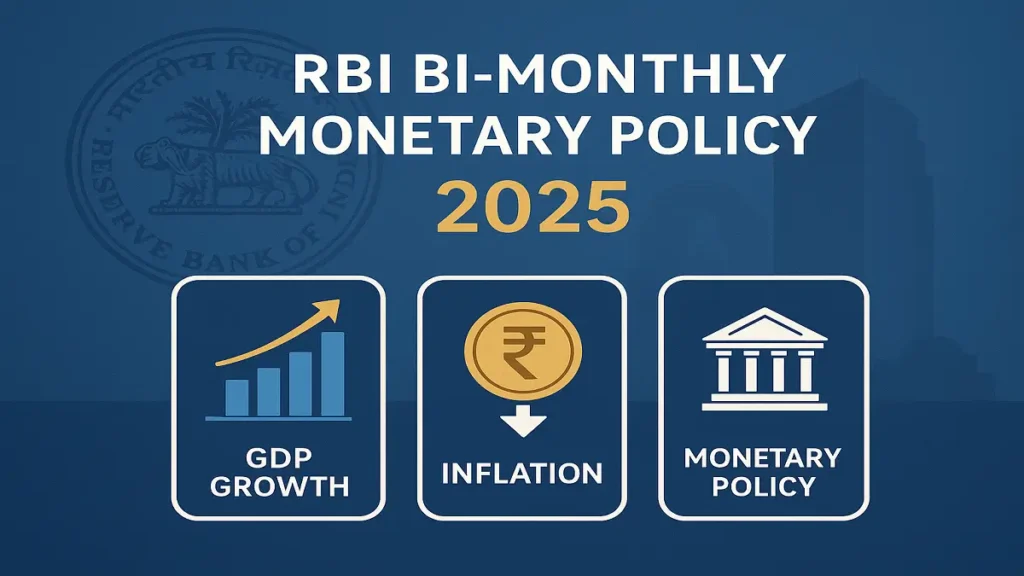RBI Holds Rates at 5.50%, Projects 2.6% Inflation, Pushes Rupee Globalisation Plan.
The Reserve Bank of India’s Monetary Policy Committee (MPC) kept the repo rate unchanged at 5.50% following its meeting on October 1, 2025.
This is the second consecutive time the MPC has held the rate steady, citing global uncertainties while adopting a “dovish pause” to allow previous rate cuts to filter through the economy.
Key Decisions & Highlights
1. Policy Rate Held Steady
The repo rate is retained at 5.50 %.
The stance remains “Neutral” — indicating no aggressive tightening or loosening, but flexibility depending on future developments.
Other related rates:
SDF (Standing Deposit Facility): 5.25 %
MSF (Marginal Standing Facility) / Bank Rate: 5.75 %
2. Macroeconomic Projections Revised
Inflation (CPI)
RBI has lowered its FY26 inflation forecast from 3.1 % to 2.6 %, on account of easing food prices and other disinflationary pressures.
Growth (GDP)
The growth estimate has been upgraded to 6.8 % from earlier.
3. Regulatory & Structural Measures
The RBI has announced several regulatory and policy reforms to support credit flow, financial stability, and to promote the internationalisation of the rupee. Some notable measures:
Internationalisation of the Rupee
Indian banks (Authorised Dealers) will be allowed to provide rupee-denominated loans to non-residents in neighboring countries (Bhutan, Nepal, Sri Lanka) to facilitate cross-border trade.
RBI to introduce official reference exchange rates for certain trading partner currencies (e.g. Indonesian rupiah, UAE dirham) to ease rupee use in trade.
Surplus rupee balances in vostro accounts of foreign entities may now be invested in corporate bonds and commercial papers, expanding beyond just government securities.
Credit & Lending Reforms
The RBI has proposed removing ceilings on lending against listed debt securities and raising limits for lending against shares (from ₹20 lakh up to ₹1 crore).
IPO financing limits also to be increased (from ₹10 lakh to ₹25 lakh) per person.
The timeline for Basel III / capital adequacy reforms (standardised approach for credit risk) has been pushed to become effective from 1 April 2027.
Expected Credit Loss (ECL) framework proposed for banks and financial institutions with a glide path over 5 years.
Foreign Exchange & Trade-related Measures
Rationalisation of rules under FEMA / ECB (External Commercial Borrowing) to simplify and make more flexible borrowing, reporting, and cost norms.
For exporters, the time for repatriation from foreign currency accounts (in IFSC) is extended from 1 month to 3 months, and merchanting trade settlement window extended from 4 to 6 months.
Consumer & Banking Sector Measures
Expansion of zero-balance or low-balance “basic savings bank deposit account” offerings to include digital banking services without penalty.
Strengthening Internal Ombudsman mechanisms for grievance redressal in regulated entities.
No plan to levy charges on UPI (Unified Payments Interface) transactions.
4. Tone & Forward Guidance
The central bank described the overall decision as a “dovish pause” — holding rates for now but leaving open the possibility of a cut later, depending on how growth and inflation evolve.
RBI noted that domestic fiscal & monetary measures are still working through the economy and warranted patience before further action.
Though inflation is comfortably below target now, the RBI remains cautious about external risks — especially global trade tensions, US tariffs, and uncertainty in global demand.
Implications & Takeaways
Borrowers (both retail and corporate) won’t see rate relief immediately, as rates are held steady.
With inflation forecast lowered, there is room for a rate cut later, possibly in December, if momentum allows.
The regulatory reforms aim to deepen credit markets, ease borrowing, and encourage use of rupee in cross-border trade.
The push for rupee internationalisation signals a strategic move to reduce dependence on foreign currencies as intermediaries in trade settlements.
Markets will now be watching whether RBI actually delivers on a rate cut in December, and how global trade and inflation scenarios evolve.
The next MPC meeting is slated for 3–5 December 2025.
Team: Creditmoneyfinance.com

